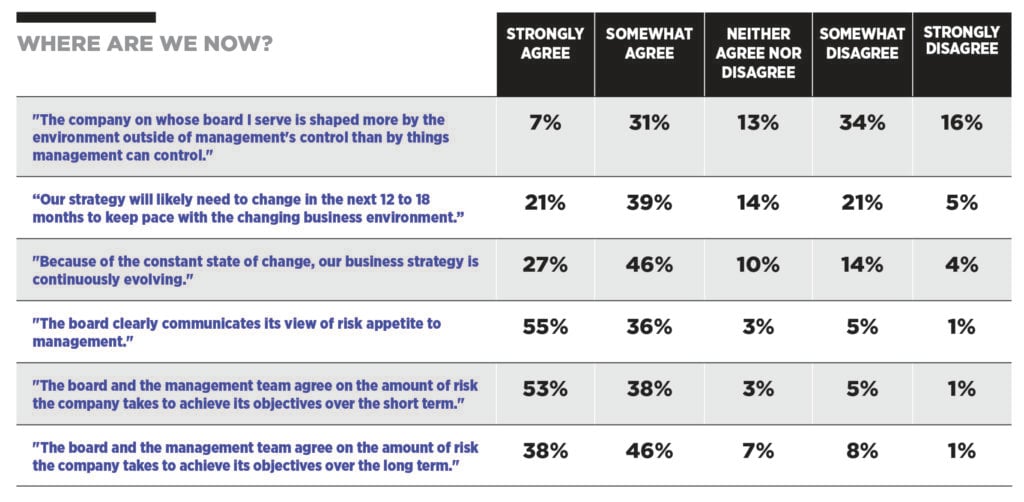Diane Creel knows firsthand what it’s like to serve on a board where open debate is not encouraged. Some years back, she was asked by an investor to join the board of a company facing a financial crisis. Hoping to help steer the company back to black, she agreed.
The rest of the story is an unfortunate lesson in what can happen when a board is beholden to a CEO, especially one who also serves as chair. Creel soon learned that dissenting voices were not encouraged and real conversations about risk and strategy rarely took place. When she raised concerns, they were quickly dismissed, and the rest of the board would simply move on to the next topic.
“It was a board of puppets,” says Creel, a former CEO who has served on a variety of boards, including TimkenSteel, Goodrich and Allegheny Technologies Incorporated (ATI), where she took the role of independent chair. Ultimately, she resigned. “I couldn’t stay on.”
Her experience is not unique. More than half of board members say they don’t feel comfortable expressing dissenting views in the boardroom, according to a recent PwC board survey of more than 700 directors. Yet, when a boardroom operates as an echo chamber, the risks to the company and its shareholders are enormous.
Open debate is critical to avoiding groupthink, identifying risks and improving strategic decision-making. “If a board is not willing to sincerely consider different perspectives, it can be very dangerous,” warns Rich Fields, who runs the board effectiveness practice at Russell Reynolds. “The decisions being contemplated often have significant dollars and other consequences behind them. Getting it wrong can be really damaging.”
Even the most well-intentioned boards can unintentionally suppress diverse opinions, says Paul Denicola, principal at PwC’s Governance Insights Center. “When you put eight or 10 or 12 human beings in a room together, there are all sorts of inherent behavioral biases that take hold that could cause an individual director to either bite their tongue when it comes to a particular topic or be less comfortable in voicing a view.”
We checked in with several directors and governance experts for some advice on how boards can build a culture where dissent is welcomed rather than silenced.
1. The chair must set the tone. “It really does start there,” says John Driver, chairman and CEO of Lynx Technology and a board member at Vital Energy and Broadway Financial. “They can have a tremendous amount of influence in the boardroom.”
Susan Fleming, director at RLI and Virtus Investment Partners, agrees that it’s the board leader’s job to ensure every voice is heard and to actively probe for alternative views. “If it’s an important issue and you, as the chair or lead director, think, ‘Huh, this is not a no-brainer decision’ but everybody is sort of just nodding and going along, to some degree you have to play a little bit of the devil’s advocate and force [the question]: Have we considered the risks? Have we considered the other side of this?”
One tool is to appoint a devil’s advocate ahead of time who knows they will be expected to challenge ideas, explore what-ifs and ensure every proposal is critically examined, says DeNicola. “It’s important that it not be the same person every time,” he adds. “You don’t want that person to become known as sort of the chronic dissenter.”
Another tactic is reordering the discussion flow. “Authority bias is real,” DeNicola explains. “If the longest-tenured director or the designated subject matter expert speaks first, others may hesitate to challenge that perspective. Instead, try having the newest directors speak first to bring in fresh views.”
2. Survey individual directors. While most public boards do regular full board assessments, most still do not do one-on-one interviews, which can make it easier for directors to openly discuss cultural dynamics. “The board benefits when it has a safe place for people to raise concerns and take stock of what’s working collectively and what might work better in the future,” Fields says.
And when you do get assessment results, don’t stick them in a drawer, says DeNicola. “No assessment is going to be effective unless there’s an action plan and follow-up that comes out of it.”
The best boards start evaluating directors’ openness to debate before they even bring them on, says DeNicola. “Ask [candidates] some behavioral questions to understand: Is this a person who’s going to be comfortable voicing a dissenting view?” And inquire about their past experience handling difficult conversations. “Tell me about a time you had to communicate a tough message. How did you do it? Did you have trouble with it? How did you overcome it?”
Fields recommends boards set “rules of engagement” for recruiting new directors. “It should be explicit: ‘This board looks for directors who are willing to challenge appropriately, bring independent thought and do the courageous thing—even if it’s hard.’”
3. Create opportunities for informal, candid discussion. Sometimes, directors hesitant to voice a contrary opinion in the boardroom will do so in less informal gatherings—and that goes for inside directors as well. Ken Gilbert, a director with Wendy’s and iAnthus Capital Holdings, says his board will invite the CEO to dinner for an open, informal dialogue about challenges and opportunities. “Occasionally, the best ideas come out of these dinners—especially if we discuss subjects not on the formal meeting agenda. At the very least, touching on some of these issues makes it easier when the full board then meets with the entire senior leadership team.”
Gilbert also relies on pre-meeting discussions. “Upon reviewing the meeting pre-read, I might give the CEO a heads up and point out something I may disagree with. The few times I’ve done this, the CEO usually helps me better understand the position or direction. The result is not having to use a valuable board meeting for unnecessary debate.”
That route also leaves more air in the agenda for impromptu discussion when a director has concerns that have not been raised. Driver notes the chair or lead director must ensure that the agenda is not so packed with management presentations that little time is left for meaningful debate or for exploring alternative strategies. “The most common text box comment I’ve seen [in assessments or surveys] is: ‘We need more time for open discussion.’”
Just be wary of too many back-channel discussions, as those can also erode trust, says Fields. “The thing that I always get nervous about is, are you pushing out discussions that should happen with the full board into bilateral off-the-record conversations?”
4. Address disruptive dissent constructively. Fleming recalls an instance where a director “used to bring up the same thing every meeting over and over and over and over.” While he wasn’t hostile, his persistence undermined his credibility and made the board less likely to listen, even when his feedback was useful. “We just eye-rolled after a while,” she says. That’s when the lead director or chair has to step in “and communicate with that person: ‘This is undermining you.’”
“You don’t want to be disagreeing all the time,” adds Creel, “but when something is extremely important, if it’s putting the board and the company in danger, you have to speak up. I mean—that’s your job.”
Directors considering board roles should try to find out ahead of time just how well a board does with dissenting views. If it seems like the culture does not welcome healthy debate, it might be prudent to take a pass.
“If I sense it’s an armchair board that’s there to rubber stamp the CEO,” says Gilbert, “that’s not a board for me.”







